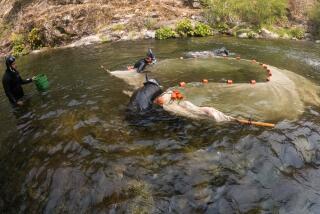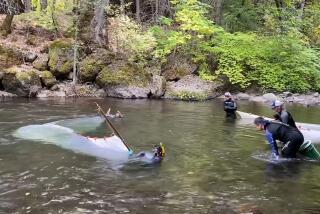Chinook Salmon Tipping Ecosystem’s Scales
- Share via
Once, Lake Michigan was stuffed to the gills with alewives, an Atlantic invader that washed up on beaches by the smelly ton. But now, fishery managers fear the fish’s population has plunged -- and that could crash the lake’s ecosystem.
Biologists blame the turnaround on the Chinook salmon of the Pacific Northwest. The most voracious fish in the lake, Chinook feed on alewives.
Fishery managers have stocked Chinook since 1967 to hold the alewives in check. Now, they plan to stock a million fewer of the rapacious predators this spring. They believe the Chinook are breeding on their own.
“The system is compensating at such a quick rate, and not in a way that we particularly want it to,” said research biologist Randy Claramunt of the Michigan Department of Natural Resources.
Although neither alewife nor Chinook are native, their presence represents Lake Michigan’s new reality, in which stocked fish are pitted against invaders.
At the heart of this new ecology is the Chinook. A $4-billion commercial and sport fishery has grown up around it and other big fish that eat alewives. So the alewife must be saved.
Lake Michigan once had a food chain so simple that a fifth-grader could draw it: Lake trout eat forage fish, which eat tiny things, which eat plankton.
But ecologists say the lake’s ecology has devolved into a complex web involving scaly immigrants from Latvia to Afghanistan, plus a smattering of game fish from elsewhere.
Among the relative newcomers are Chinook, coho salmon, and brown and rainbow trout. The trout were introduced for sport fishing in the late 1800s. The coho and Chinook were bred with hopes of curbing alewives. The Chinook at least fulfilled fish managers’ dreams.
By now, native fish -- trout, chubs, whitefish and the like -- have been banished to far-flung pockets of the lake and may or may not survive.
Alewives blundered up the St. Lawrence Seaway and Welland Canal in 1949. Their only plausible native threat were lake trout -- big, ancient, deepwater fish who by then were dying off thanks to invading lampreys and thiamin deficiency.
Natives of Newfoundland, the alewives wandered the lake in great shimmering assemblies. Grasping opportunity in their “troutless” new world, they multiplied, overate and then themselves died -- in shocking abundance and all over pricey lakefront real estate. Fish managers started pouring in Chinook, reasoning that they might do something about the alewives while providing a few nice days of fishing in a lake that only years earlier had been a wasteland of lampreys.
If the system was out of balance before, it is little better now.
After a favorable season in 1998, the amount of alewives in Lake Michigan weighed some 132 million pounds -- this for a fish weighing four ounces. In 2005, the alewives’ cumulative bulk plunged to 55 million pounds, while the number of Lake Michigan Chinook soared. In the early 1990s, alewives had weighed in at 220 million pounds.
Last summer, scientists found reduced numbers of alewives, and those they caught were scrawny. Even the populous Chinooks have been slimming down, ecologists say.
And it’s not as though the lake would return to its historic balance if the alewives and Chinook died off, Claramunt said.
“Can we ever get rid of alewives in the Great Lakes?” he asked. “Probably not.”
Ecologists suspect there are a host of other fish on the sidelines, looking for an advantage in the Chinook-alewife tussle.
“I can’t say what would happen, but I am confident that outcome would be undesirable,” Claramunt said.
The goal is to prevent any new dominance from developing.
“Easiest to fix is reducing the predators,” said Tom Trudeau, Lake Michigan program coordinator for the Illinois Department of Natural Resources. “Chinook is the target species because Chinook is the one species most dependent on alewives.”
So the Chinook will be pared back, solving the problem for now but prolonging the lake’s love-hate relationship with the alewife.
This year’s Chinook fingerlings, still small enough that several would fit in a sardine tin, will be released in May. After that, everything depends on how they interact with other lake life.
“Everything looks real good right now,” said Tom Hays, the assistant hatchery manager in Manito.
Just don’t tell the alewives.
More to Read
Sign up for Essential California
The most important California stories and recommendations in your inbox every morning.
You may occasionally receive promotional content from the Los Angeles Times.













